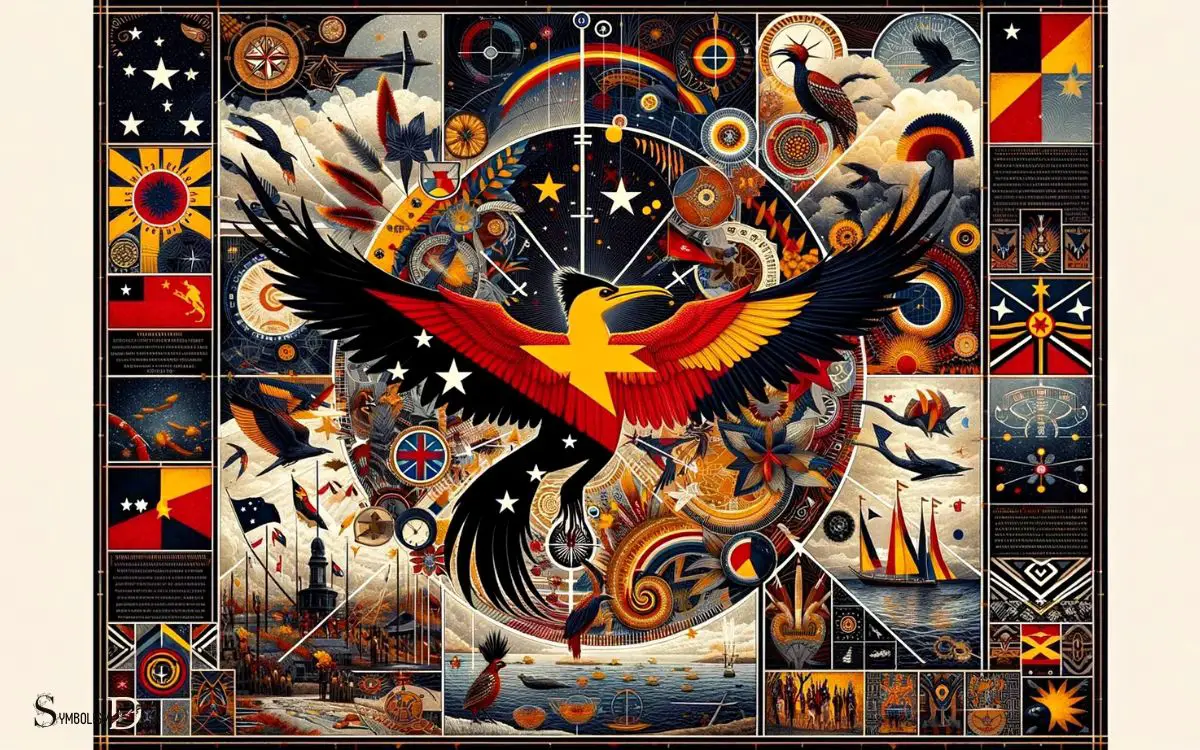What Do the Symbols on the PNG Flag Mean? Aspirations!
The Papua New Guinea (PNG) flag features a black and red field with the Raggiana bird-of-paradise and the Southern Cross.
The red represents the country’s traditional heritage and future aspirations, while black symbolizes the indigenous people. The Southern Cross signifies navigation, and the bird-of-paradise represents freedom and cultural richness.
The symbolism on the PNG flag is deeply rooted in the country’s identity. For instance:
- Black and Red: The two primary colors of the flag, where black is emblematic of the indigenous Melanesian people and the red stands for the island’s rich traditions and bright future.
- Raggiana Bird-of-Paradise: This bird, depicted in its traditional dance pose, is a national emblem that signifies the diverse bird species in PNG and is a symbol of cultural heritage and natural beauty.
- Southern Cross: The constellation is a navigational beacon for seafarers and symbolizes the connection of PNG to the other nations of the Southern Hemisphere.
Embracing the spirit of Papua New Guinea, the flag’s symbols serve as a beacon of unity, guiding the nation towards a harmonious future while honoring its storied past.

Key Takeaway
History of the PNG Flag

The history of the PNG flag dates back to the country’s gaining of independence in 1975. The flag was officially hoisted for the first time on July 1, 1971, and it was designed by 15-year-old schoolgirl Susan Karike Huhume.
The flag symbolizes the country’s cultural heritage and independence aspirations. The flag was raised to replace the Australian flag, signifying the end of colonial rule and the beginning of a new era for Papua New Guinea.
The flag’s design was chosen through a nationwide competition, with Susan’s entry being selected as the winning design.
This pivotal moment in the nation’s history marked the beginning of a new chapter, celebrating Papua New Guinea’s unique identity and independence.
This historical context sets the stage for a closer examination of the flag’s design elements and colors.
Design Elements and Colors

The design elements and colors of the PNG flag hold significant cultural and historical symbolism.
- The bird of paradise represents the nation’s cultural heritage and diversity.
- The Southern Cross symbolizes the country’s geographical location in the Southern Hemisphere.
- The black color reflects the Melanesian people, their struggles, and their aspirations for independence.
- The red, yellow, and white colors represent the country’s national flower, the kumul, and its traditional cultural values.
These design elements and colors are a visual representation of Papua New Guinea’s rich cultural heritage, its aspirations for independence, and its unique place in the world.
Southern Cross Constellation

The Southern Cross constellation holds a significant place in the symbolism of the Papua New Guinea flag. Its representation on the flag reflects the country’s geographical location in the Southern Hemisphere.
Understanding the cultural significance and historical context of the Southern Cross on the flag provides valuable insights into the nation’s identity and heritage.
Png Flag Symbolism
Discussing the symbolism of the Southern Cross constellation on the PNG flag unveils its historical and cultural significance.
The representation of the Southern Cross on the flag carries deep meaning for the people of Papua New Guinea, symbolizing their connection to the stars and the navigational skills of their ancestors.
The Southern Cross also signifies the country’s geographical location in the Southern Hemisphere and its close relationship with other Pacific nations.
Moreover, the constellation holds spiritual significance, representing unity and harmony among the diverse indigenous groups within the nation.
The Southern Cross on the flag serves as a reminder of the country’s identity, heritage, and the values upheld by its people.
Transitioning into the subsequent section about ‘southern cross representation’, the symbolism of this constellation extends beyond national flags.
Southern Cross Representation
Representing both the geographical location and cultural heritage of Papua New Guinea, the Southern Cross constellation holds significant symbolism on the national flag.
The Southern Cross is a prominent feature of the flag, symbolizing the country’s location in the Southern Hemisphere and its connection to the wider Pacific region.
The constellation also holds cultural significance, representing navigation, guidance, and the interconnectedness of the various indigenous groups across the country.
The four large stars and one smaller star of the Southern Cross are arranged in a distinctive pattern on the flag. This representation serves as a reminder of the country’s rich cultural diversity and the unity of its people.
| Star | Meaning |
|---|---|
| Alpha (α) | Unity |
| Beta (β) | Progress |
| Gamma (γ) | Peace and prosperity |
| Delta (δ) | Love and understanding |
| Epsilon (ε) | Happiness and hope |
Cultural Significance Explained
Continuing from the previous subtopic, the cultural significance of the Southern Cross constellation on the Papua New Guinea flag is rooted in its representation of navigation, guidance.
The interconnectedness of indigenous groups, with each of its stars symbolizing unity, progress, peace and prosperity, love and understanding, and happiness and hope, respectively.
Unity: Represents the coming together of diverse ethnic groups and the strength found in unity.
Progress: Signifies the nation’s journey towards development and advancement.
Peace and Prosperity: Reflects the aspiration for tranquility and abundance within the country.
Love and Understanding, Happiness and Hope: Embodies the values of compassion, empathy, joy, and optimism that are integral to the cultural fabric of Papua New Guinea.
These symbols encapsulate the aspirations and values cherished by the people of Papua New Guinea, serving as a source of pride and identity.
Bird of Paradise Symbolism

The Bird of Paradise holds significant symbolism in the culture of Papua New Guinea. It represents grace, beauty, and freedom. Its portrayal on the flag reflects the country’s rich biodiversity and unique wildlife.
Understanding the cultural significance of this bird provides insight into the values and traditions of the people of Papua New Guinea.
Bird of Paradise Representation
The symbol of the Bird of Paradise on the PNG flag holds significant cultural and historical significance.
The Bird of Paradise representation on the flag symbolizes several important aspects of Papua New Guinea’s identity, including:
- Cultural Diversity: The Bird of Paradise represents the diverse cultural heritage of the country, with over 800 languages spoken and a rich tapestry of traditions.
- Unity: The presence of the Bird of Paradise on the flag signifies the unity of the people of Papua New Guinea despite their diverse backgrounds.
- Natural Beauty: The Bird of Paradise is renowned for its vibrant plumage and unique courtship dances, reflecting the country’s rich natural beauty and biodiversity.
- Historical Significance: The Bird of Paradise has been revered by indigenous communities for centuries, making it an emblem of historical continuity and tradition.
Cultural Significance of Bird

Why is the Bird of Paradise symbolism culturally significant in Papua New Guinea?
The Bird of Paradise holds immense cultural significance in Papua New Guinea, symbolizing the country’s unique and diverse culture.
Representing the nation’s rich and vibrant cultural heritage, the Bird of Paradise is deeply ingrained in various aspects of Papua New Guinean society, including traditional rituals, ceremonies, and artistic expressions.
The bird’s extraordinary beauty and distinctiveness are revered by the indigenous people, often associated with qualities such as grace, freedom, and the interconnectedness of the natural world.
Its symbolism extends beyond aesthetics, embodying the spirit of Papua New Guinea’s people and serving as a proud emblem of the country’s identity.
The Bird of Paradise holds a revered place in the hearts and minds of Papua New Guineans, showcasing the nation’s deep cultural roots and the significance of its natural environment.
Traditional Motifs and Meanings

Traditional motifs and their meanings on the PNG flag are deeply rooted in the cultural heritage and history of Papua New Guinea. The motifs represent significant aspects of the country’s identity and values,
including:
- The Southern Cross: Symbolizing the country’s geographical location in the Southern Hemisphere and its close ties with other Commonwealth nations.
- Bird of Paradise: Representing the nation’s rich and diverse wildlife, as well as its cultural significance in local traditions and rituals.
- The Raggiana Bird of Paradise: Specifically reflecting the unique species found in Papua New Guinea, known for its vibrant colors and elaborate courtship displays.
- The Hiri Moale Festival: Depicting the traditional sailing canoes and the significance of the Hiri trade cycle in the country’s history and economic development.
These motifs encapsulate the essence of Papua New Guinea’s cultural and natural heritage. Understanding their meanings provides insight into the nation’s identity and values.
The evolution of the flag over time further exemplifies the changes in the country’s history and aspirations.
Do the Symbols on the Australian Flag Have Similar Meanings as the Symbols on the PNG Flag?
The symbols on the australian flag hold different meanings compared to the symbols on the PNG flag. While the Australian flag features the Union Jack, representing its historical ties to British colonization, the PNG flag portrays unique symbolism. Its emblem signifies cultural diversity, with the bird of paradise symbolizing national identity, and the Southern Cross representing the country’s location.
Do the Symbols in Dreams Represent our Desires and Aspirations?
The dreams symbolic meaning desires is a subject of great fascination and debate. Many believe that the symbols we encounter in our dreams represent our deepest desires and aspirations. These symbols, often veiled in metaphor and visual imagery, offer a glimpse into our unconscious mind. By decoding these symbols, we may unravel the hidden meanings behind our yearnings and ambitions, providing insight into our innermost selves.
Evolution of the Flag Over Time

Representing the country’s evolving history and aspirations, the evolution of the PNG flag over time reflects significant changes and developments in Papua New Guinea’s identity and values. Papua New Guinea’s flag has undergone several changes since its inception.
The original flag, adopted at the country’s independence in 1971, featured the Southern Cross constellation and a bird of paradise, representing the country’s connections to the Commonwealth and its indigenous fauna.
In 1975, the flag underwent a significant redesign, incorporating the red and black colors of the national emblem.
The flag’s current design, adopted in 1975, features the red and black colors, symbolizing the indigenous people and their link to the land, along with the Southern Cross and the bird of paradise.
These changes reflect the country’s evolving national identity and its journey towards independence and self-determination.
Conclusion
In conclusion, the symbols on the PNG flag hold deep cultural and historical significance for the people of Papua New Guinea.
The Southern Cross represents the country’s connection to the Southern Hemisphere, while the Bird of Paradise symbolizes the nation’s unique and diverse wildlife.
The traditional motifs and colors on the flag reflect the rich cultural heritage of the country.
Overall, the flag serves as a powerful symbol of national identity and pride for the people of Papua New Guinea.







